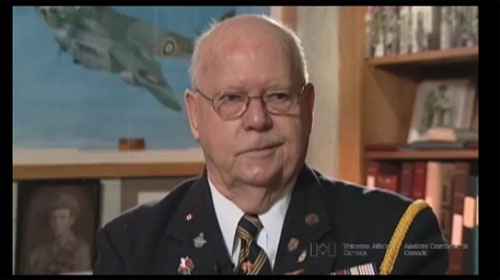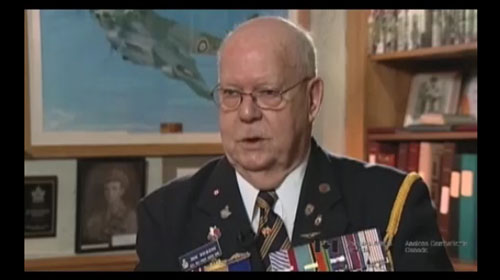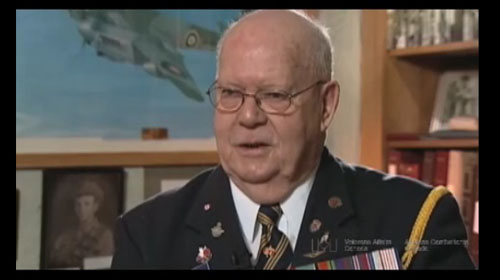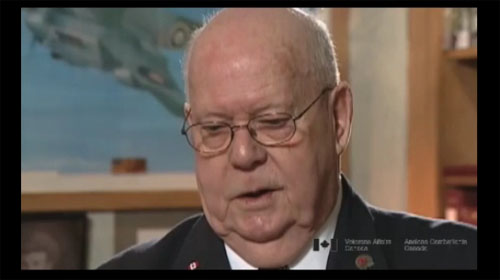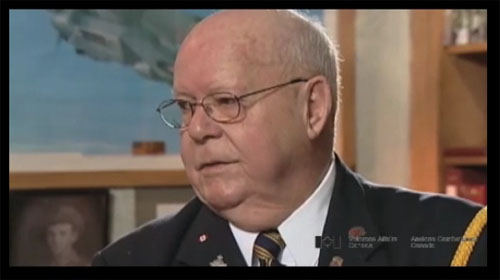Crew Friendly Aircraft
Heroes Remember
Crew Friendly Aircraft
Current position:00:00:00
Total time:--:--:--
The Halifax, it was the most crew-friendly aircraft of the works
On take offs, the navigator and the wireless operator came out
of down below the others, we would go back to the rest position
on either side of the aircraft just like it was a little couch
or a little bed... lie down, plug in the intercom and lie there
and wait until you got the take-off. Because it’s too dangerous
and same thing with landing, when you go to land we’d go back
into our rest position. You could walk the whole length of the
fuselage from the rear gunner right through to the nose,
other than walking down the stairs under the bomb aimer.
The main escape hatch was right at my feet. In a pinch all I had
to do was reach down, pull the thing, lift it up, turn it and
drop the thing through and there’s a great big hole. The other
guys could go out where we climbed into the aircraft. So there
are two major exits. The Lanc bomber was far different.
The bomb aimer and the engineer with the big bomb bay that the
Lanc had, that’s what made it so popular, had a big blockbuster
bomb; four-thousand pounds or something. So it took up a great
deal of the bomb bay, sorry, the bomb bay took up a great deal of
the fuselage, up into the fuselage. So the main spars, there was
two of them, went right through the aircraft. With the Hali,
it was below, below the floor. But in the Lanc it was halfway
up into the aircraft to make room for that big bomb bay. So you
had to climb over this big spar on two occasions. So the bomb
aimer was trapped, or at least the navigator was trapped in
one, and the engineer was trapped in the other between these
two main spars. So that if anything happened you had a hell of a
time getting out of there. As I say, in the Hali you could just
walk right through. So that’s why I say it’s crew friendly and I
just loved it. The pilots liked the Lanc because it was newer and
had more powerful motors and all this sort of thing. But the
Halifax was the best as far as I’m concerned. In the Halifax,
the bomb aimers sat beside the pilot but would you believe I
had to go downstairs to my position which... so the bomb aimer
would have to stand up and let me get by his chair or seat which
was in... came out of the wall on the opposite side of the pilot.
You go downstairs and the wireless operator sat underneath the
pilot and the navigator position was forward of the wireless
operator and the table was sideways. So my seat came out of the
wall and then I would sit opposite my table with the wireless
operator on my left. Further to my right was the bombing station
so when the bomb aimer had to get up to come down to drop the
bombs, I would have to stand up to let him go by, okay?
So that’s how that aircraft was. So the pilot was way up there
and I was down here! But we had intercom and so on so that I
would give him a new course through the intercom.
The only time I looked out, there was no point in me looking
out at night, you can’t see! Unless you take a sextant to
shoot the stars and then I’d have to get up and go back behind
the bomb aimer. There’s an astrodome... see the glass bubble on
the top of the plane. I don’t know whether it’s on this picture
over here. Anyways, you would shoot the stars there, take your
readings and then go back down and plot them, you see. But that’s
the only time that you would find it necessary to go and look
out. You’re too busy doing your job trying to plot your course,
find out where you were and so on.
Related Videos
- Date modified:



